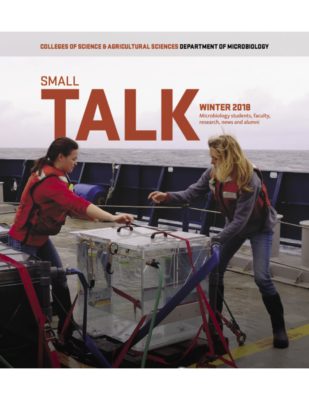Eric earned his Ph.D. today! He gave an excellent, data-rich seminar – and I couldn’t be more pleased by his work, dedication, and accomplishments. He moves on now to a post-doc position at Los Alamos National Labs – he will be missed at OSU.

Phytoplankton Physiological Ecology
Eric earned his Ph.D. today! He gave an excellent, data-rich seminar – and I couldn’t be more pleased by his work, dedication, and accomplishments. He moves on now to a post-doc position at Los Alamos National Labs – he will be missed at OSU.

Eric’s work on VOCs produced by a diatom. Many of these VOCs are consumed by SAR11, causing the diatom to work 20% harder to keep up with the bacterial demand! Eric compared VOC production by T. pseudonana in monoculture and in co-culture with HTCC1062. He used PTR-ToF/MS and a clever experiment using a hydrocarbon trap to show the impact of VOC consumption on carbon fixation rates. Published in Environmental Microbiology.
Michelle completed her MS in May, 2019 – discovering some very exciting genetic controls of phytoplankton growth rate. Look for the paper on this topic in the near future! Here we are wishing her safe travels (left to right: me, Eric, Michelle, Bryce, James).

Here’s our Department’s new newsletter! Cleo and I made the cover, and there’s a nice little blurb on the lab’s work inside.

Kelsey’s paper is out!
McBeain and Halsey (2018). Altering phytoplankton growt rates changes their value as food for microzooplankton grazers. Aquatic Microbial Ecology 82:19-29. doi.org/10.3354.ame01880
This was an interesting study that required some pretty amazing skills – well done, Kelsey!
Eric passed his preliminary exam! Making it over this hurdle is always worth celebrating – congratulations, Ph.D. candidate, Eric Moore!
Cleo and Bryce were hard at work for the month of September out in the North Atlantic. Cleo continues collecting data on volatile organic compounds that are cycled among members of the marine microbial community. If cycling becomes uncoupled, these VOCs can be released into the atmosphere with wide ranging climate effects. Bryce was responsible for measuring net primary production, so he spent a lot of time in the rad van (where he can use radiolabeled isotopes). Once in awhile he was free to enjoy the vast sea. The last of the four cruises is coming up quickly in March, 2018…

Congratulations to post doc Cleo Davie-Marin who received an award to study the volatile organic carbon metabolome. This award will help her to develop a new incubation technique to investigate VOC “fingerprints” produced by the abundant cyanobacterium, Synechococcus sp. This work builds on the momentum developed through her mentorship of undergraduate researcher, Duncan Ocel. Duncan and Cleo are an adventurous team, both scaling rocks and seeking other adventures whenever not in the lab, where they are also exploring new territory.
Our newest lab paper was published today. This manuscript describes two important discoveries in diatom lifecycles.
PLoS ONE 12(7): e0181098. https://doi.org/10.1371/journal.pone.0181098
1.) Thalassiosira pseudonana IS a sexual diatom species
2.) Ammonium induces sex in T. pseudonana and at least two other centric diatoms.
To prove these discoveries, Eric Moore with help from Briana Bullington carried out a number of carefully controlled culturing experiments, imaged all of the cell morphologies in the lifecycle, and identified >1,200 genes that were differentially expressed under conditions of ammonium induced cell differentiation. Some of these genes are involved in meiosis, flagellar synthesis, and sex differentiation.
Thanks to all of our co-authors, Alex Weisberg, Jeff Chang, and Yuan Jiang for their help with gene expression analysis and statistical testing.
Nobody had ever seen the model centric diatom, Thalassiosira pseudonana, undergo sexual reproduction. Grad student, Eric Moore, documented the sexual stages and showed upregulation of genes involved in meiosis and flagellar synthesis. Moreover, he figured out what triggers these diatoms and other centric diatoms to shift into the sexual cycle resulting in cell enlargement. Read about it here on BioRxiv.
doi: https://doi.org/10.1101/144667

© 2025 Kimberly Halsey
Theme by Anders Noren — Up ↑